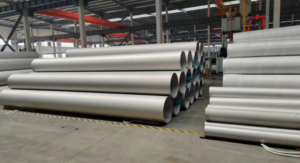Incoloy 901 alloy and Incoloy 926 alloy, as two crucial alloy materials, play significant roles in various industries such as aerospace and petrochemicals due to their exceptional high-temperature resistance, corrosion resistance, workability, and oxidation resistance. However, they exhibit notable differences in composition, properties, and applications. In this blog post, let’s take a closer look at the differences between Incoloy 901 Alloy and Incoloy 926 Alloy.

5 Major Differences between Incoloy 901 Alloy and Incoloy 926 Alloy:
Firstly, in terms of material composition, Incoloy 901 alloy is an austenitic age-hardening alloy primarily composed of nickel, chromium, iron, and titanium, which endow it with remarkable heat and corrosion resistance. Conversely, Incoloy 926 alloy, a nickel-based alloy, incorporates abundant chromium, molybdenum, and manganese, among other elements, resulting in exceptional comprehensive properties.
Secondly, when it comes to corrosion resistance, Incoloy 901 alloy’s chromium content enhances its corrosion resistance, particularly in acidic, alkaline, saline, aqueous, and oxidizing media. Meanwhile, Incoloy 926 alloy’s blend of corrosion-resistant elements offers superb pitting and crevice corrosion resistance, capable of withstanding sulfuric acid, oxidizing acids, chlorides, fluorides, and other aggressive media.
Thirdly, regarding high-temperature resistance, Incoloy 901 alloy boasts outstanding performance, maintaining good mechanical properties and structural integrity at temperatures up to 1100°C. Similarly, Incoloy 926 alloy also exhibits good high-temperature resistance, with chromium in its composition forming a protective oxide layer at elevated temperatures, enabling it to withstand temperatures up to 1038°C.
Furthermore, in terms of workability, Incoloy 901 alloy’s nickel base, coupled with additions of chromium, molybdenum, titanium, aluminum, and niobium, not only enhances strength and corrosion resistance but also imparts excellent hot and cold workability. Incoloy 926 alloy, too, exhibits good workability, tolerating high deformation temperatures during hot working. Additionally, its superior work-hardening properties allow for deep cold forming.
Lastly, in terms of application scope, Incoloy 901 alloy boasts high yield and creep strength below 650°C and maintains good oxidation resistance at 760°C. Thus, it is widely used in aerospace components like combustion chambers, turbine blades, and high-temperature exhaust systems. Incoloy 926 alloy, with its unique chemistry, is suitable for chemical, petroleum, and marine engineering applications due to its exceptional corrosion and high-temperature resistance.
Conclusion
In conclusion, Incoloy 901 alloy and Incoloy 926 alloy, as superior high-temperature alloy materials, play pivotal roles in modern industries owing to their remarkable corrosion resistance and high-temperature strength. However, their differences in composition, properties, and applications necessitate careful selection based on specific performance requirements and application scenarios.
Why Choose Huaxiao Alloy?
Thank you for reading our article and we hope it can help you to have a better understanding of the differences between Incoloy 901 Alloy and Incoloy 926 Alloy. If you are looking for suppliers and manufacturers of Incoloy alloy, we would advise you to visit Huaxiao Alloy.
As a leading supplier of Incoloy alloy from Shanghai China, Huaxiao Alloy offers customers high-quality Incoloy 800/800H/800HT, Incoloy 825, and Incoloy 925/926(AL-6XN).



